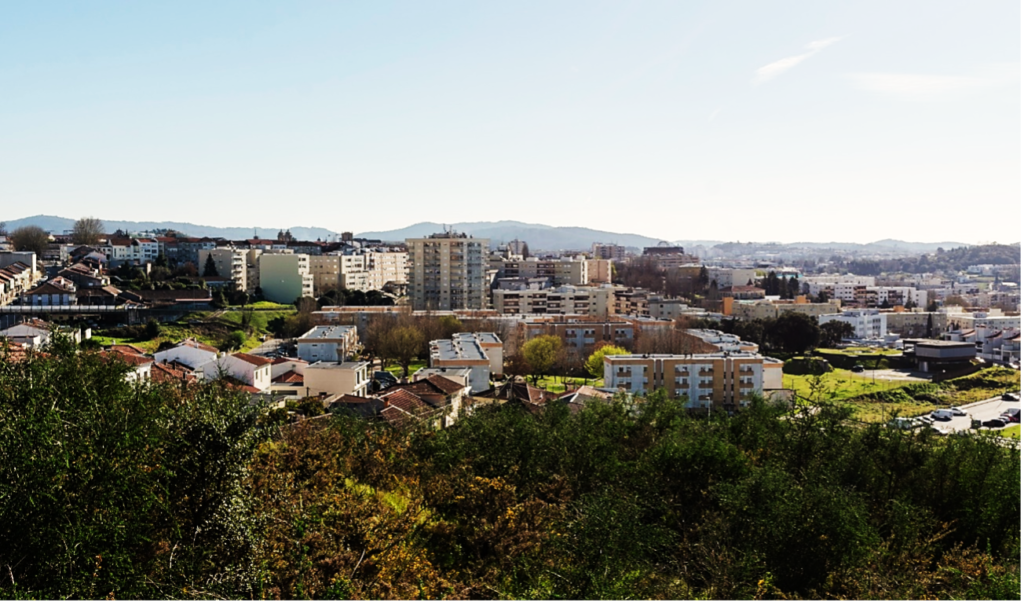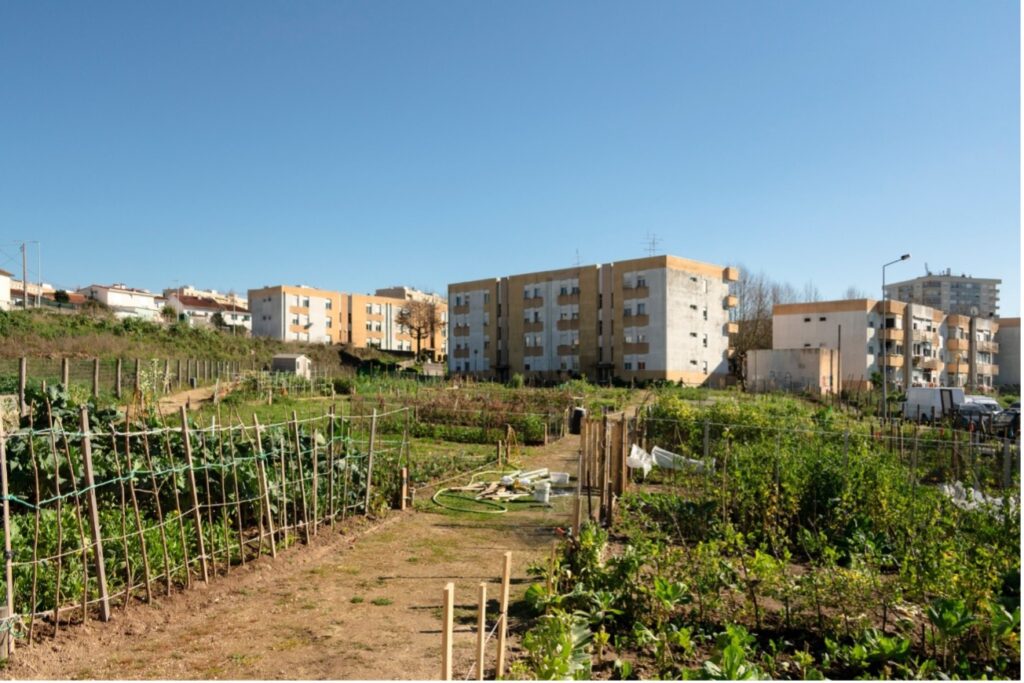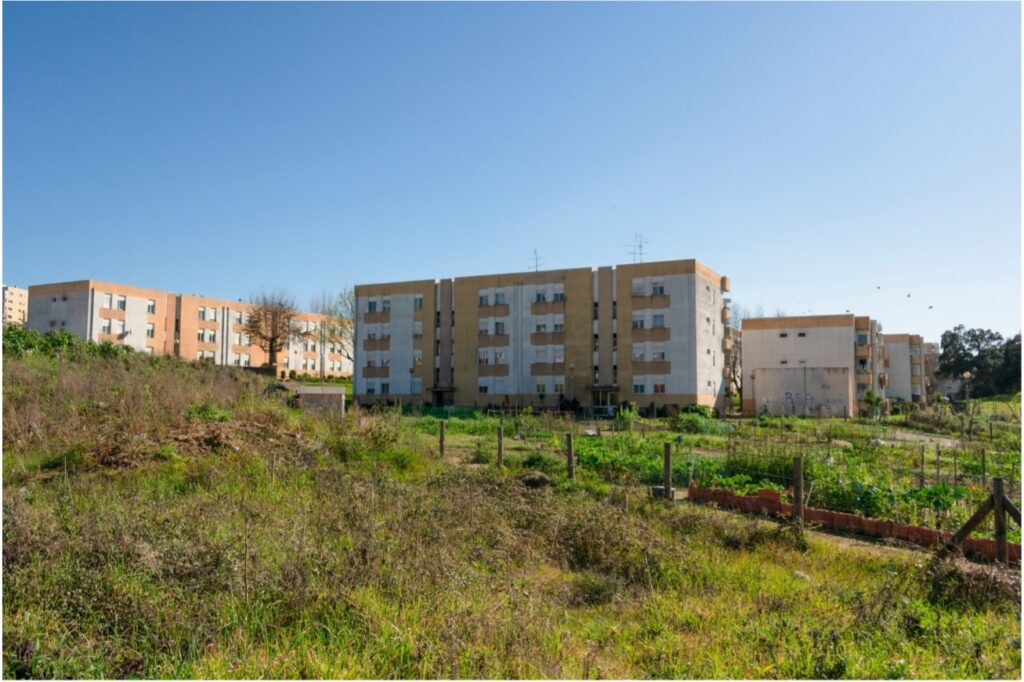Virgínia Pereira
When planning a community urban garden, certain issues must be considered. The first one to consider is the reason for its investment, and this involves asking about the social, economic, and environmental problems that must be faced. Then one must select the place that exhibits the most urgency in setting up a community urban garden. Defining the goals that must be achieved is a significant step for the project’s success. Another crucial point is to describe how the project engages with the climate change problem. Is this a mitigation or an adaptation strategy? Or both? Preparing urban gardening also involves financial and resource management issues, which raise a different set of questions. Who funds the urban gardening project? Who cedes the land to cultivate? For how long can beneficiaries cultivate the land provided? What kind of plants should be cultivated? What resources should be available? Who manages the garden?
The urban gardening project in Andorinhas Neighborhood, Braga
The urban gardening project in the city of Braga is an initiative of the City Council of Braga and the Environmental Fund, which is an institution that supports environmental policies and sustainable development and ensures compliance with environmental objectives and commitments. In the words of Rui Rio, Mayor of the City Council of Braga, this represents the encounter between urban reality and sustainability. The urban gardening project in the city of Braga began in 2016 and since then community urban gardens have been inaugurated in several neighborhoods in the city, such as Andorinhas Neighborhood, which was set up in 2019. The setting up of a community urban garden in the Andorinhas Neighborhood is also promoted by the Parish Council of São Vicente and the Resident’s Association of Andorinhas Neighborhood. The beneficiaries of this project are the residents of this neighborhood.
The Andorinhas Neighborhood is a social-housing neighborhood situated in São Vicente parish in Braga, Portugal. This neighborhood was built over three years, between 1983 and 1986, and comprises thirty-two residential edifices, inhabited by around two thousand people. In addition to the residential spaces, there are six shops, a multi-sport rink, a children’s playground, a workout park, and a community urban garden. The neighborhood is located in the northwest section of the city and is delimited to the south and east by Rua Fernando Castiço, to the west by Rua Dr. Pereira Caldas, and Rua Dr. Manuel Braga da Cruz, to the north and west by the uncultivated land. This is not a place that other residents of the city pass through or visit. The urban ring road, which is an important road traffic channel, composes a physical barrier between the neighborhood and the central area of the city. Crossing into the neighborhood is done through the streets below this highway, which makes it a gloomy place because of its darkness. This contributes to the characterization of this neighborhood as a marginal place. Near the neighborhood, there is no equipment or service that justifies a visit from an outside visitor. The general opinion – of inhabitants from other zones of the city – is that this neighborhood is not attractive and when visiting it, not even its green spaces are pleasant.

This project envisions social inclusion through inequality attenuation. Since the Andorinhas Neighborhood was built to provide shelter to those who face financial and economic difficulties, and most people who live in this neighborhood earn low wages, in some cases lower than the national minimum wage, this urban project supports an alternative to food provision. This project also promotes biological agriculture and a healthy lifestyle and encourages the conservation of biodiversity and urban nature. Besides, it aims to produce pleasant urban landscapes from an urbanistic viewpoint. Together, these goals envision the revitalization of unused spaces to benefit the population, potentiating a wider usage and also instigating a sense of community, as well as, providing environmental and ecological education.
The Andorinhas Neighborhood reveals a particularly interesting example of urban gardening due to its peripheral features and being a working-class neighborhood. The garden has an entrance and a delimited area. Its usage agreement is renewable every year and this reveals to be one of the project’s shortcomings – further clarified. One must apply to the Resident’s Association of Andorinhas Neighborhood to get a plot. The applicant must fulfill some conditions, which are: the applicant must reside in the geographical area of the parish and the proximity of her/his residence in relation to the garden is taken into account. The economic situation is essential for assessing the allocation of the land. If the application satisfies these conditions is given a plot that measures between 15 and 25 square meters. And each gardener can share a common waterpoint and a shank to keep small tools. When assigned the plot, the occupant is given a card that identifies the number of the patch and is also allowed to attend training in agriculture.

Figure 2 Community urban garden in Andorinhas Neighborhood viewed from Rua Senhora do Monte. Photo by Ana Nogueira.
A resident from the neighborhood described it as “the neighborhood of the poor, of the laborer”, the precarious neighborhood, and revealed that, in the beginning, instead of a community garden, it would be another building, perhaps a residential building. Nevertheless, between the two, as the inhabitant said, the garden was the best choice and that empty space is no longer “a pile of rubbish”. The inhabitant also confessed that “at least we have a piece of land to work and put the soup on the table” and affirmed that the community urban garden improves the urban way of life and “when there is land to cultivate there are a few vegetables to feed the family”.

Figure 3 Community urban garden in Andorinhas Neighborhood viewed between Rua Fernando Castiço and Rua Senhora do Monte. The garden is delimited by trunks and wire and behind there is uncultivated and wasted (green) space. Photo by Ana Nogueira.
A project with shortcomings
There are shortcomings and a few critical points about the execution of this project. Starting with the cession of the space, that is, the period of time that inhabitants benefit from this project and the amount of land available. Despite the land use agreement being renewed every year, this project turns out to be ineffective to attenuate the financial and economic inequality because the dwellers are not given any certainty that they will continue to have land available to cultivate to obtain food next year. We cannot forget that plants need their own time to grow and harvest. The amount of land ceded to the community might not be enough to satisfy all population and this also fails when attempting to reduce the financial and economic inequality. The plot distribution among the beneficiaries of this initiative seems dissimilar, that is, the plots were not assigned in equal parts. However, that can be a small detail. The distribution of plots is still in progress, and this remains a problem. Either the organization and criteria of distribution are unsuitable, or the population doesn’t have the interest to cultivate the land. That is, the population hasn’t achieved yet an environmental consciousness and the entities mentioned haven’t done anything to address this issue.
Another shortcoming is garden maintenance. Despite the dwellers’ efforts, the garden is not preserved properly. At its margins, garbage can be seen. The City and the Parish Councils, together with the resident’s association, must ensure that the garden is kept clean, decreeing proper care for this space.
The usage of biofertilizers and composting must be encouraged when implementing such an urban project. The dwellers are not inspired to use biowaste or composting as a fertilizer, instead they use chemicals to grow their plants.
Considering the aesthetic point of view, the garden’s frame does not highlight any kind of beauty but rather illustrates decay. Even if the garden is no longer seen as a pleasant structure but as an alternative to obtaining food, the embellishment of the urban landscape must be taken into account.
Community resilience is a major shortcoming of this project. The same resident from the community said that everyone does according to their abilities to maintain the space. Nevertheless, “each one” seems to refer to an individual and not a member belonging to the community. This means, that the members of the community don’t come up together to maintain a clean space or elaborate an irrigation system.
The garden does not have any irrigation system. The dwellers only have a faucet and a hose to water the plants, which they share among themselves. There is no sustainable and efficient irrigation system that discharges essential amounts of water for irrigation. Also, there is no evidence of dwellers’ intentions to create one, since there are no monetary resources or they simply do not want to.
There is no evidence of continuous participation of the City Council and the Parish Council. Their participation was possibly limited only to ceding the land. The City Council and the Parish Council should continuously intervene to support the community.
Adaptation or mitigation strategy?
Due to the climate change problem, new alternatives for a living have been arranged, like installing a garden in an urban space. These alternatives are mitigation or adaptation strategies. Installing a garden in an urban space stand for an adaptation strategy by adopting a new alternative to obtain food or a mitigation strategy by being aware of food waste and consumption.
Urban gardening might be the new farming. An important lesson taken by both strategies is «take what the land gives, harvest what the land produces». This means that, although the goal is to satisfy the population, the land productivity must be taken into account, and is crucial to be alert to food consumption and waste, and overproduction because this may wash out the land and its reduction.
The urban gardening project engages with the climate change problem as a promotion of sustainability that meets urban life and stands for a resilient search for new ways to get food. The gardens give urban space a better quality of life, create more fresh air, sensibilize to food overproduction and, consequently, stimulate environmental consciousness.
A project with limitations
Some limitations interfere with the effective execution of this project. The garden’s placement constitutes a physical limit. The garden places nearby only one building and that might discourage the residents to cultivate. Another limitation might be the resident’s education level, the most did not attend compulsory education, and, therefore, may not be susceptible to learning new topics, for instance, environmental issues. The pollution around the garden hampers land conservation. So, this urban project still has no visible effects and that obfuscates the neighborhood image to the outsiders and it contributes even more to a marginal picture.
A project leading to broader changes
This initiative can lead to broader changes. It purchases the sense of community with dwellers coming up together to preserve their living urban space and work on their resilience, creating effective ways to protect their garden and urban landscape.
The urban gardening project contributes to environmental education being the keyword awareness, firstly, about the issues that have been emerging due to the problem of climate change and then in what ways that changes have impacted people’s lives.
A wider broader change is the implementation of an urban garden for all over the city adjusting to the necessities of each community.
A replicable project
This urban project is replicable, mainly in concept. This means that the implementation of urban gardens should be, unceasingly, a way of intervening in urban space due to the problem of climate change and enhancing urban landscapes. In the Andorinhas Neighborhood case, more work must be done in its design, organization, and environmental education.
References
Abertas as candidaturas para Hortas Comunitárias do Bairro das Andorinhas. (s.d.). Got from Associação dos Moradores do Bairro das Andorinhas: http://ambandorinhas.blogspot.com/
Anonymous. (February de 2022). The Community Urban Garden in the Andorinhas Neighborhood. (V. Pereira, Interviewer)
Economia Circular em Freguesias (JUNTAr+). (s.d.). Got from Fundo Ambiental: https://www.fundoambiental.pt/avisos-anteriores/avisos-2019/residuos-e-economia-circular/economia-circular-em-freguesias-juntar.aspx
Martins, S. F. (2017). Segregação socio-espacial em Braga: o caso de estudo do Bairro das Andorinhas. Repositorium: http://repositorium.sdum.uminho.pt/bitstream/1822/54435/1/Sara%20Filipa%20Lopes%20Martins.pdf
Município de Braga reforça aposta na criação de hortas urbanas. (2016). Got from de Câmara Municipal de Braga: https://www.cm-braga.pt/pt/0201/home/noticias/item/item-1-4102
Silva, J. P. (s.d.). Hortas urbanas nas freguesias de Gualtar e S. Vicente disponíveis até ao final do ano. Got from Correio do Minho: https://correiodominho.pt/noticias/hortas-urbanas-nas-freguesias-de-gualtar-e-s-vicente-disponveis-at-ao-final-do-ano/120599